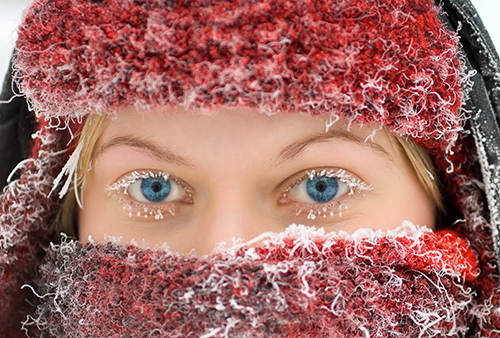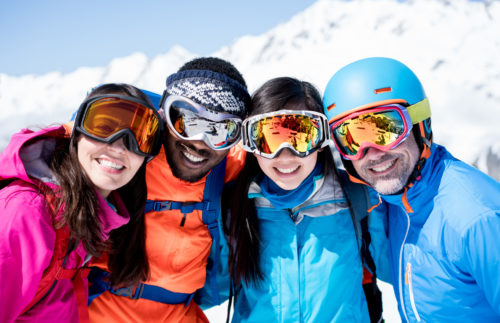Prevent Winter Eye Problems
Dry Eyes and Snow Blindness are More Common in Winter
Winter eye care tips by Donald McCormack, M.D.
Ophthalmologist at Boulder Medical Center
Frigid temperatures and seasonal winter weather have finally settled into Boulder County. Along with Colorado’s beautiful winters, there is a risk that dropping temperatures, harsher winds, and dryer air will negatively impact our eyes’ health. Bright sun, reflective snow, and traveling to higher elevations also present unique challenges. That’s why paying special attention to eye health during the colder months is essential.
Here are the most common problems and tips to help you take good care of your eyes this winter.
Dry Eyes in Winter
Tears are a mixture of water, fatty oils, and mucous that provide a protective layer on our eyes’ surface. Although our eyes are constantly producing tears, the tears also naturally evaporate. When this cycle is balanced, our eyes function perfectly and feel fine. However, cold air holds less water in winter than warm air, so dry eyes are more common. Wind can increase evaporation, too. This is why almost everyone will experience eye irritation on the coldest days for these reasons. Symptoms of dry eyes can include redness, itchiness, burning, stickiness, and a foreign body sensation in the eye.
Several measures can help with dry eyes:
- Purchase over-the-counter artificial tears such as Refresh and Systane. These products supplement our natural tears and can be used as often as six times a day. Some preservative-free varieties can be used even more often. Apply a drop of artificial tears before you head out into the cold and wind to help keep your eyes comfortable;
- Use humidifiers to improve your indoor environment;
- Decrease drafts, avoid fans, and direct heating vents away from your face when in the home. These solutions help decrease evaporation that occurs when air moves across the eyes;
- Avoid cigarette smoke. Smoke can increase eye irritation;
- Always wear sunglasses or ski goggles when outdoors. Be sure to retain eye moisture when outside, especially when engaging in activities where air moves quickly across your eyes, such as snowboarding, skiing, and snowmobiling;
- Decrease the amount of time you wear contact lenses. Lenses can wick tears away from your eyes;
- Ask your ophthalmologist for chronic or severe dry eyes. An ophthalmologist is a medical or osteopathic doctor specializing in eye and vision care. They are experts in the full spectrum of treatments for dry eyes, including the insertion of tear duct plugs. These tiny, biocompatible devices can be quickly and painlessly inserted into your eyes to help relieve dry eyes.
Discover more about dry eye remedies.
Watery Eyes and Cold Weather
Watering eyes are familiar as we step outside into colder winter temperatures. When cold air causes more evaporation, our eyes have a thinner cushion of tears protecting sensitive surface cells. This condition can trigger a reflex that tells the lacrimal gland (the eye gland that secretes an aqueous tear film layer) to produce extra tears. The result is that tears can flood our eyes and spill onto our cheeks.
In this case, the tearing is actually due to evaporation; treatment for watery eyes is similar to dry eyes.
Snow Blindness
Photokeratitis is the medical term for snow blindness caused by damage to the surface cells of the cornea from ultraviolet (UV) light. Although we are exposed to UV light all year, reflections from snow intensify this exposure. That’s why photokeratitis usually happens in winter. The cornea cells have denser nerve endings than anywhere else on your body, making snow blindness extremely painful. The damage, while often temporary, can cause blurry vision. UV light can also damage the retina in the back of the eye.
The best way to prevent snow blindness is to avoid prolonged UV exposure. All sunglasses and snow goggles sold in the United States must have filters blocking UVA and UVB rays. Adequate protection for snow sports is critical.
Treating snow blindness involves resting with the eyes closed for 12 to 48 hours. If necessary, your ophthalmologist can provide symptomatic and pain relief.
Eyes at Altitude
Traveling at higher elevations exposes our eyes to even colder temperatures and less protection from UV light. Hence, dry eyes and the risk of snow blindness increase the higher you go. If you enjoy Colorado mountain activities like skiing, snowboarding, sledding, snowshoeing, and snowmobiling, taking extra precautions to protect your eyes is vital.
About Donald McCormack, M.D.
Ophthalmologist in Boulder, CO
 Dr. McCormack diagnoses and treats all eye diseases, prescribes eyeglasses and contact lenses to correct vision problems, and performs various clinical procedures and more complicated eye surgeries. He has a special interest in treatments for dry eyes and glaucoma and has been a principal investigator in numerous clinical research trials.
Dr. McCormack diagnoses and treats all eye diseases, prescribes eyeglasses and contact lenses to correct vision problems, and performs various clinical procedures and more complicated eye surgeries. He has a special interest in treatments for dry eyes and glaucoma and has been a principal investigator in numerous clinical research trials.
Originally from Ames, Iowa, Dr. McCormack has been with the Boulder Medical Center since 1993. Here is a partial list of the services he provides:
- Complete eye exams for adults and children
- Cataract Surgery — standard, toric, and multifocal lenses
- Glaucoma — medical and laser treatments
- Diabetes — retinal laser surgery
- Dry Eyes — medical treatments and punctal plugs
- Glasses and Contact Lenses
Visit Dr. McCormack’sFull Profile



